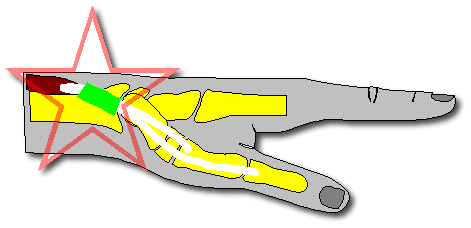| What is it? |
-
DeQuervain's tendinitis is a painful problem which results from irritation
of tendons on the side of the wrist which move the thumb sideways away
from the palm. It can result in wrist and forearm pain on the side of the
thumb, particularly with certain positions and movements of the wrist.
|

| What caused it? |
-
It is most often noticed after unaccustomed activity involving repeated
lifting or side to side motion of the wrist. It can also develop for no
clear reason. The problem is due to irritation of two tendons at a point
where they run through a very tight channel ("the first dorsal compartment")
from the forearm to the thumb. Many people have two small separate channels
for the tendons and are particularly predisposed to this problem.
|

| What can you do to help? |
-
Avoid wrist positions and activities which are painful, if possible.
-
Ice for five to fifteen minutes at a a time on the area which is most swollen
and tender.
-
"Over the counter" non-steroidal anti-inflammatory medication (NSAID),
such as aspirin, ibuprofen, naprosyn, or ketoprofen.Check with your pharmacist
regarding possible side effects and drug interactions.
-
A splint or brace which supports both the wrist and the thumb. A wrist
support splint which doesn't support the thumb is not as effective as one
that does.
-
Wait and watch.
|
| What can a therapist do to help? |
-
Provide a variety of hand splints to support the thumb and the wrist.
-
Help identify aggravating activities and suggest alternative postures.
-
Massage, heat, ice and other treatments aimed at making the area more comfortable.
|
| What can a doctor do to help? |
-
Confirm that this actually is the problem.
-
Prescribe stronger NSAID medication or cortisone-type medication.
-
Prescribe hand therapy and/or a custom prescription splint.
-
Give a cortisone shot into the area of the most irritation.
-
Perform surgery to enlarge the tight channel so that the tendons no longer
chafe.
|
| How successful is treatment? |
-
Many people with mild symptoms will improve with a limited period of anti-inflammatory
medication and avoiding painful activities, especially if the problem developed
during unaccustomed strenuous activities. It is less likely to resolve
if it is related to light repetitive work activities.
-
A cortisone shot into the sore area helps most people - at least temporarily.
When temporary, relief usually lasts about two months. One or two shots
provide permanent relief for as many as two out of three people with this
problem.
-
Surgery helps over four out of five people with this problem, but as many
as one out of five will have a new problem after surgery, such as numbness
on the back of the hand or tenderness of the scar.
|
| What happens if you have no treatment? |
-
It depends on how much it is bothering you - it really is a quality of
life issue. This is not a problem which can spread to other parts of your
body or which must be treated within a limited period of time. Some people
will have a mild problem which flares up from time to time, and treat it
themselves or ignore it, others will have a severe problem which prevents
them from doing many things with their hand, and feel that they have no
choice but to have surgery.
|
|



